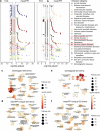mFusion: a multiscale fusion method bridging neuroimages to genes through neurotransmissions in mental health disorders
- PMID: 39719509
- PMCID: PMC11668864
- DOI: 10.1038/s42003-024-07404-x
mFusion: a multiscale fusion method bridging neuroimages to genes through neurotransmissions in mental health disorders
Abstract
Mental health disorders emerge from complex interactions among neurobiological processes across multiple scales, which poses challenges in uncovering pathological pathways from molecular dysfunction to neuroimaging changes. Here, we proposed a multiscale fusion (mFusion) method to evaluate the relevance of each gene to the neuroimaging traits of mental health disorders. We combined gene-neuroimaging associations with gene-positron emission tomography (PET) and PET-neuroimaging associations using protein-protein interaction networks, where various genes traced by PET maps are involved in neurotransmission. Compared with previous methods, the proposed algorithm identified more disease genes on both simulated and empirical data sets. Applying mFusion to eight mental health disorders, we found that these disorders formed three clusters with distinct associated genes. In summary, mFusion is a promising tool of prioritizing genes for mental health disorders by establishing gene-PET-neuroimaging pathways.
© 2024. The Author(s).
Conflict of interest statement
Competing interests: The authors declare no competing interests.
Figures







References
-
- World Health Organization. World mental health report: Transforming mental health for all. World Health Organization (2022).
-
- Andersen, P. H. et al. Securing the future of drug discovery for central nervous system disorders. Nat. Rev. Drug Discov.13, 871–872, (2014). - PubMed
MeSH terms
Grants and funding
LinkOut - more resources
Full Text Sources
Medical

